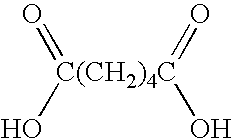Polymeric polyol esters from trihydric polyols for use in metal working with improved solubility
- Summary
- Abstract
- Description
- Claims
- Application Information
AI Technical Summary
Benefits of technology
Problems solved by technology
Method used
Image
Examples
Embodiment Construction
[0008] The polymeric polyol ester of this disclosure is made from the following components. The first is a generally linear monocarboxylic acid where R is an alk(en)yl group of 11 to 19 carbon atoms.
[0009] The second is an alkanedioic acid such as adipic acid shown below.
[0010] The third is an alk(en)yl substituted succinic acid or its anhydride where R1 has from 15 to 20 carbon atoms.
[0011] The fourth is a trihydric alcohol and in the preferred embodiment is trimethylolpropane as shown below.
[0012] The fifth component in embodiment A is not present in any substantial amount in embodiment B. The fifth component when present is pentaerythritol as shown below.
[0013] When these components 1-5 are reacted it can form a polymeric polyol ester as described in embodiment A and shown below. A variety of isomeric variations therefrom with more numerous side chain branches is anticipated rather than a strictly linear structure as shown.
[0014] The polymeric polyol ester is manufact...
PUM
| Property | Measurement | Unit |
|---|---|---|
| Pressure | aaaaa | aaaaa |
| Solubility (mass) | aaaaa | aaaaa |
| Molecular weight | aaaaa | aaaaa |
Abstract
Description
Claims
Application Information
 Login to View More
Login to View More - R&D
- Intellectual Property
- Life Sciences
- Materials
- Tech Scout
- Unparalleled Data Quality
- Higher Quality Content
- 60% Fewer Hallucinations
Browse by: Latest US Patents, China's latest patents, Technical Efficacy Thesaurus, Application Domain, Technology Topic, Popular Technical Reports.
© 2025 PatSnap. All rights reserved.Legal|Privacy policy|Modern Slavery Act Transparency Statement|Sitemap|About US| Contact US: help@patsnap.com



